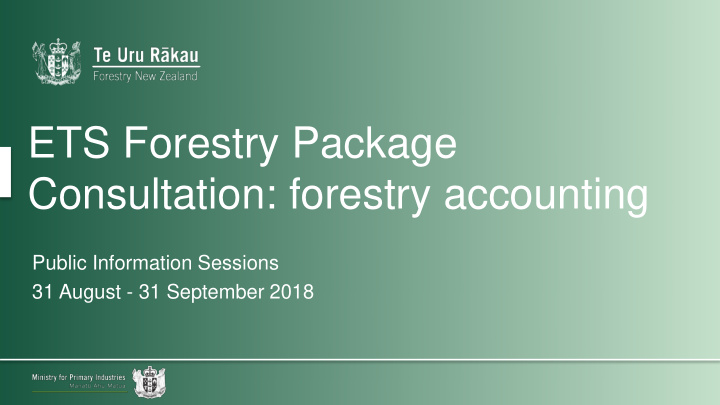



ETS Forestry Package Consultation: forestry accounting Public Information Sessions 31 August - 31 September 2018
ETS forestry accounting proposals Averaging design settings Averaging accounting Accounting for ‘new’ forests Average carbon stock and age Accounting for ‘existing’ forests Less ongoing reporting Harvested Wood Products Complementary proposals proposals Remove temporary adverse Harvested Wood Products event liabilities value in ETS averaging Extend offsetting planting to post- Harvested Wood products “industry good” fund 1989 forests 2
ETS Review Findings for forestry from the review: Current ETS accounting barrier to participation Major issues for participants with post- 89 forests Averaging accounting opportunity Harvested Wood Products opportunity
Current ETS Accounting Storage of carbon assumed under different accounting Current carbon accounting 1200 approaches “ Carbon stock- change” accounting 1000 tCO2/ha (NZU/ha) Production forest “saw tooth” 800 600 Carbon stock-change issues 400 Accounting for harvest liabilities: 200 Safe carbon o Reduces participation and 0 afforestation incentive 1 3 5 7 9 111315171921232527293133353739414345474951535557596163 Forest Age o Requires ongoing reporting Current Accounting Decay Growth 4
Averaging accounting proposal Rotation Cycle under averaging Storage of carbon assumed under different accounting 1200 approaches Establishment/Planting 1000 Growth up to the average tCO2/ha (NZU/ha) 800 Long term average 600 Less ongoing reporting 400 200 Harvesting (no liabilities) 0 Deforestation/Deregistration 1 3 5 7 9 111315171921232527293133353739414345474951535557596163 Forest Age Averaging Current Accounting Decay Growth 5
Averaging accounting proposal Units received and surrendered under different Proposal to use averaging in the accounting approaches 1200 ETS: 1000 Participants only receive units on tCO2/ha (NZU/ha) 800 their forests first harvest rotation 600 No units received or surrendered 400 for harvesting/regrowth past forests “long term average” 200 safe carbon 0 Still surrender units for 1 4 7 10 13 16 19 22 25 28 31 34 37 40 43 46 49 52 55 58 61 64 Forest Age deforestation Averaging Current Accounting 6
Questions? 7
‘ New’ and ‘existing’ forests
Averaging accounting for ‘new’ forests Proposal for all people that register ‘new’ forests in the ETS to use averaging accounting Increased Afforestation Reduced Liability Financial Boost Incentive 9
‘ New’ and ‘Existing’ Forest ‘New’ forest ‘Existing’ forest Post-89 forests which are not Newly established forests (i.e. ‘new’ from 1 January 2020) Post-89 forests established before Planted on bare land/not “ forest defined date for ‘new’ forests (i.e. land” (post -89 land) Determined by date of before 1 Jan 2020) Existing forests are defined by establishment, not date of registration in ETS date of establishment, not date of To be finalised after consultation registration in ETS 10
Accounting for ‘existing’ forests Proposal to have one of three accounting options for people with existing forests in the ETS: the current accounting approach averaging accounting a one-off, one-way option for current or averaging 11
Accounting for ‘existing’ forests Existing forests use current accounting: Business continuity Short term fiscally positive; long term international misalignment Two classes of post-89 forests (new + existing) Existing forests use averaging accounting: Lower harvest liabilities One simple accounting approach Short term unit supply impact/long term international alignment Existing forests one-off, one-way accounting choice: Ability to decide best approach Short term uncertain unit supply impact; long term more internationally aligned Mix of accounting approaches (two classes of forest) 12
Averaging transition for ‘ e xisting’ forests Examples of transition unit flow 1200 tCO2/ha (NZU/ha) 1000 Transition proposal for participants with 800 “existing” forests: 600 400 Transition at end of a MERP 200 0 Repay “above average” NZUs 1200 1 6 11162126 1 6 11162126 1 6 11162126 1 tCO2/ha (NZU/ha) 1000 Current Accounting 800 Slower NZU repayment proposal: 600 400 Repay NZUs over two MERP 200 0 1 6 11162126 1 6 11162126 1 6 11162126 1 Current Accounting Average 13
Questions? 14
Averaging accounting design proposals
How to calculate the average age? Design details to consider: Measurement/Tables Carbon stock as (or at) an age Forestry types/species Rotation age bands 16
Changes to the average age Design details to consider: Average age set in regulations Preferred - Government changes to regulations not retrospective 17
Ongoing reporting Current ETS reporting requirement: Detailed reporting each MERP Averaging reporting proposals for participants: Detailed reporting until forests’ average age Less detailed reporting after forests’ average age i.e.: o Confirm continued management each MERP o Detailed reporting for significant changes 18
Questions? 19
Complementary Proposals
Temporary adverse event proposal Indicative carbon storage 800 700 Re-start Average No longer require participants using Adverse earning 600 Event averaging to surrender NZUs for 500 t CO2/ha temporary forest carbon reductions: 400 de-risks forestry investment 300 200 better reflects Crown impact under 100 Paris Agreement 0 0 2 4 6 8 10 12 14 16 18 20 22 24 26 28 30 32 34 36 38 40 21
Post-89 offset planting proposal ETS participants can offset deforestation emissions liabilities – by planting a carbon equivalent forest: increases land use flexibility, which could: o increase ETS participation; o assist economic development and environmental planning Apply pre-1990 offsetting rules (later in presentation) 22
Questions? 23
Harvested Wood Products
Harvested Wood Products (HWP) Current international accounting Instant oxidisation – assumes all emissions released at harvest What is harvested wood products accounting? Slow decay – recognises wood products release carbon at different rates: o longer lived-wood products release carbon slowly o Short-lived wood products release carbon quickly 25
HWP proposals 800 700 tCO2/ha (NZU/ha) 600 Provide NZUs to ETS participants through 500 400 averaging: 300 200 Increases afforestation incentive: 100 0 o The average would be higher, which 1 6 11 16 21 26 31 36 41 46 51 56 61 66 71 76 81 86 91 Forest Age increases financial return from carbon Averaging with HWP Averaging without HWP forestry OR Set up a longer- lived HWP “industry good” fund: Increases incentive to create longer-lived wood products: o Could increase Crown value/climate change mitigation 26
Recommend
More recommend